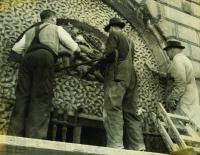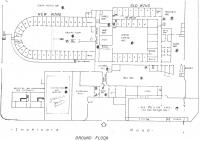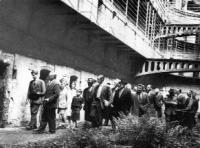‘The wilderness years’:Kilmainham Gaol, 1924–1960
Published in
20th-century / Contemporary History,
Features,
Issue 6 (Nov/Dec 2010),
Volume 18

Volunteers begin work restoring the chained serpents above Kilmainham Gaol’s main entrance. As a result of this inspiring voluntary restoration project, which began in 1960, the gaol was preserved as a monument for future generations. (Kilmainham Gaol)
Kilmainham Gaol, now long established as a national monument, is a unique resource in the study of Irish history. Every year many thousands of visitors make their way there, most often as a result of the effusive recommendation of inhabitants of the capital city, to absorb something of Irish social, penal and political history in the period from the 1790s to the 1920s. As a result of an inspiring voluntary restoration project, which began in 1960, the gaol was preserved as a monument for future generations, with the motivation for the project being, in particular, the commemoration of the many political prisoners (a virtual roll-call of the Irish nationalist pantheon) who were imprisoned there. The gaol is now managed by the Office of Public Works, which had leased the building to the voluntary restoration committee for some 26 years (1960–86). In retrospect one might ask why this restoration work needed to be carried out by a voluntary group at all—why successive Irish governments, in times of greater nationalist feeling, did not instigate or at least actively support or finance such a project.
Following the removal of the last republican prisoners in the early months of 1924, Kilmainham Gaol was never again used as a place of confinement. The prison was evacuated by the Irish Free State army in March of that year, when care of the gaol reverted to the General Prisons Board of Ireland. Having no need for the prison at the time, the Prisons Board carried out no maintenance whatsoever on the building over the following years and the gaol began to fall into disrepair.
The National Graves Association
A statutory order officially closing the premises was made by the Minister for Justice on 1 August 1929 and, in accordance with the General Prisons (Ireland) Act 1877, Kilmainham Gaol was automatically transferred to Dublin County Council on the expiration of one year from that date. Almost immediately after this transfer, the county council was to come under pressure over its new acquisition. Letters were received from the National Graves Association (NGA) enquiring as to the council’s intentions with regard to the property. The NGA had been formed in
1926 with the objective of commemorating all those who died in the cause of Irish independence. They had an understandable interest in establishing a permanent commemoration to the patriots executed in Kilmainham Gaol.
The NGA’s honorary secretary,
Seán Fitzpatrick, urged the council to consider opening the gaol for visitors during the Eucharistic Congress in the summer of 1932 to highlight Irish patriotic endeavour both to Irish people and to the many foreign visitors. His suggestion, however, was turned down by the council. Later in the year Fitzpatrick wrote to the Minister for Local Government, Seán T. O’Kelly (himself a former prisoner in Kilmainham during the Civil War), requesting that he receive a deputation from the NGA ‘to discuss the question of permanently marking the place where the men of 1916 and four of the 1922 men were shot, also the enclosing of the place of burial of the men hanged in 1883 [the Invincibles]’. O’Kelly later raised the matter with Eamon de Valera, who appears to have approved of the proposal, and it was agreed that the matter would be passed on to the Commissioners of Public Works (henceforth the Board of Works) for consideration. The first of a number of surveys and estimates on developing the gaol as a national monument were carried out, which also involved consultation with the National Museum.
Deemed unsuitable as a museum

Plan of the gaol drawn up by the OPW in 1996. (Kilmainham Gaol)
Early proposals by the Board of Works encountered opposition from the Minister for Education, Tomás Derrig (another Civil War Kilmainham prisoner), who expressed the view that the buildings were generally unsuitable for conversion to museum purposes. As an alternative, the department put forward a suggestion by the director of the National Museum, Adolf Mahr, that—following the example of Nationalist Spain, where the former republican prison in Madrid was preserved as a place of remembrance—the galleries and cells should be retained in their existing state and that memorial tablets should be provided to recall the history of the liberation movements. In other words, the gaol would be more a shrine than a museum; there would be no need for any exhibits.
This suggestion may have reflected the National Museum’s concerns that their most popular collections, those illustrating Irish political history, would be removed from Kildare Street. Mahr stressed that the gaol was unsatisfactory for museum purposes both because of its location and because of the great expense necessary to convert it adequately for such purposes. Mahr knew the mentality of the Department of Finance and his emphasis on expenditure probably helped to ensure the temporary shelving of the project. Nonetheless, the Fianna Fáil government’s apparent interest, however lethargic, in developing the gaol continued; at a meeting of the executive council on 4 December 1936 it was finally decided that the gaol premises would be acquired by the state from the county council and that the main building would be preserved and the remaining buildings demolished to make way for a public park. Over a year later, however, the gaol building had still not been purchased from the county council.
Long queues at open day
With Seán Fitzpatrick continuing in his efforts to exert pressure on the government, the media briefly rallied to his cause. On 14 March 1938 the Irish Press featured a prominent article that included an interview with Fitzpatrick, under the title ‘Shall Kilmainham fall?’ The article elaborated on Fitzpatrick’s proposal, as well as publishing his plans for the treatment of the 1916 plot and the ‘Invincibles’ plot in the form of a memorial park. A special open day, organised by Fitzpatrick and other members of a Seán Heuston Memorial Committee, was permitted by the council on Sunday 19 March and vast crowds visited the gaol. As the Irish Times recorded:
‘From mid-day to 6pm there was a constant stream of people, and the queue, which waited outside for admission, stretched at times to about a quarter of a mile. Over a hundred stewards were on duty to act as guides to the various places of interest, and there was also a large detachment of Civic Guards and members of the St John Ambulance Brigade. Most of the guides obviously had a keen interest in their work. They have studied the history of the prison, and many had vivid stories to tell of escapes, executions and famous men.’
Later in the same year the gaol and the adjoining land were finally purchased by the Board of Works for the nominal sum of £100. The low price was agreed on the understanding that the prison would be restored as a museum. Following the acquisition, more estimates and surveys were carried out by the Board of Works, along with further consultation with the National Museum. These deliberations were, however, halted in 1939 with the outbreak of war in Europe, and plans for the gaol museum slid out of focus. In 1945 the Department of Posts and Telegraphs and the Department of Finance both enquired as to the possibility of the gaol premises being adapted for office accommodation. The Public Records Office also requested additional storage accommodation and the suggestions put forward included the adaptation of the gaol, ‘giving 15,000ft of shelving, the provision of a new wing at one end of the main hall for stairs, lifts, office and sanitary accommodation, and the demolition of the remaining buildings’. These proposals (as well as that for a defence museum) were not accepted, mainly on the grounds of the cost involved. Although this continuing highly unsatisfactory situation was raised in the Dáil in 1946, no action was taken and the gaol continued to fall into decay. By the early 1950s it was considered a dangerous building, with serious risk of falling debris in parts of the site. In August 1953 a cabinet committee meeting finally decided that the gaol should be converted to a museum with a small memorial park and that with this adaptation no permanent wall or structure would be removed. On 28 August a press release was issued confirming that the government ‘have recently decided that Kilmainham Gaol should be preserved as a national monument, and the necessary steps to that end are being put in place’.
Negative mind-set

Former prisoner Seamus Brennan (second from left)—under sentence of death in 1916—leading a site inspection by the provisional restoration committee in May 1960. (Kilmainham Gaol)
The ‘necessary steps’ were in fact not taken and the situation continued to stall. In 1954 a new coalition (non-Fianna Fáil) government assumed office. This interparty government included the Labour Party, and one of its members, John O’Leary, appeared to make the party position on Kilmainham very clear in the Dáil on 15 June:
‘We believe that the spending of money on Constellations [a reference to Aer Lingus’s acquisition of Constellation aircraft at this time] and on schemes such as the building of the Bray Road, Kilmainham Gaol, and on new government buildings, should cease. We believe that all these schemes were nonsense and should not have been introduced by Fianna Fáil. I often wonder how Deputy de Valera allowed his party to introduce them.’
This kind of depressingly negative mind-set, not uncommon in this period, continued to hamper any hopes of progress. Goaded by the remarkable government inaction (and rumours that the Board of Works were inviting tenders for the demolition of the jail), the baton, which had been held for so long by Seán Fitzpatrick, was taken up by a Dublin engineer, Lorcan Leonard, who began to gather support for a voluntary restoration project. Leonard was very successful in bringing together a group of concerned citizens (including veterans of the struggle for independence, architects, lawyers, tradesmen, etc.) to form a provisional restoration committee in 1959. Public meetings were held to outline the proposals for the gaol. An impressive project proposal was submitted to the government by Leonard. At a government meeting on 26 February 1960 the restoration committee’s proposed project was finally approved. Among some of the older government ministers there may have been a measure of relief to have the fate of the gaol settled at no expense. Care of the ‘national shrine’ would be someone else’s responsibility.
In conclusion, it seems remarkable that these ‘wilderness years’, when Kilmainham Gaol fell into a serious state of decay, continued for so long. With a little imagination Fianna Fáil (in government for so much of the period discussed) could have exploited the site in their own interest. Indeed, with so many of the party having associations with the gaol, most famously de Valera (under sentence of death in 1916 and the last prisoner held in the gaol after the Civil War), it is difficult to understand why there was so much procrastination and inertia on their part regarding this issue. Seán Fitzpatrick, on the other hand, deserves credit for his vision of developing the gaol as a national monument and for his perseverance with that aspiration. His endeavour, and that of other little-known men and women who came to share his vision (beyond the scope of this brief essay), represents a unique and inspiring instance of active citizenship and passionate voluntarism towards a patriotic cause in modern Irish history. HI
Rory O’Dwyer lectures in history at University College Cork.
Further reading:
P. Cooke, A history of Kilmainham Gaol (Dublin, 1995).
N. O’Sullivan, Every dark hour: a history of Kilmainham Jail (Dublin, 2008).
A photographic exhibition on the restoration will run in Kilmainham Gaol Museum until 16 January 2011. Admission is free.



















